CBSE Previous Year Question Papers Class 12 Economics 2012 Outside Delhi
Time allowed : 3 hours
Maximum marks: 100
** Answer is not given due to change in the present syllabus
CBSE Previous Year Question Papers Class 12 Economics 2012 Outside Delhi Set – I
Section – A
Question 1.
Define microeconomics. [1]
Answer:
Micro Economics is the branch of Economics, in which we study the behaviour of individual. Economic units like a firm, a consumer, an industry etc.
Question 2.
Give one reason for a shift in demand curve. [1]
Answer:
A demand curve shifts when there is a change in a factors other than own price of the product.
Question 3.
What is the behaviour of Total Variable Cost, as output increases? [1]
Answer:
When output increases total variable cost also increases initilly at a decreasing rate. After a point it increases at increasing rate.
Question 4.
What is the behaviour of Marginal Revenue in a market in which a firm can sell any quantity of the output it produces at a given price? [1]
Answer:
In the given situation marginal revenue in the market will always remain the same. This situation known as perfect competition.
Question 5.
What is a price-maker firm? [1]
Answer:
A price maker firm is one which participates in fixing the price of the product.
Question 6.
Define Production Possibilitiy Curve. Explain why it is downward sloping from left to right. [3]
Answer:
A production possibility curve is a hypothetical representation which represents the amount of two different goods that can be produced with the full use of given resources in an economy under technological conditions.
PP curve slopes downward from left to right because of the fact that in a combination if we produce more of one good with limited resources, the less we produce of the another good.
Question 7.
A consumer consumes only two goods X and Y and is in equilibrium Price of X falls. Explain the reaction of the consumer through the Utility Analysis. [3]
Answer:
The basic condition fulfilling the condition of consumer’s equilibrium when two commodities according to utility analysis is :
\(\frac{\mathrm{MU}_{x}}{\mathrm{P}_{x}}=\frac{\mathrm{MU}_{y}}{\mathrm{P}_{y}}\)
If the price of X falls, per rupee marginal utility of X will increase and becomes more than that of Y. The consumer will transfer expenditure from Y to X, and will buy more of X.
Question 8.
Draw Total Variable Cost, Total Cost, and Total Fixed Cost curves in a single diagram. [3]
Answer:
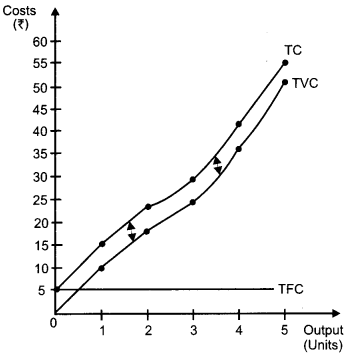
In the short period the total cost is the sum of total variable cost (TVC) and total fixed cost (TFC). Total variable cost initially increases with the increase in output at a decreasing rate and after that it increases at an increasing rate. Therefore total cost initially increases at a decreasing rate and after that increases at an increasing rate.
Question 9.
A producer starts a business by investing his own savings and hiring the labour. Identify implicit and explicit costs from this information. Explain. [3]
Answer:
Implicit cost: The producer is using his own savings in his business which elsewhere would have earned interest. Therefore the value of the interest on the savings invested is implicit cost.
Explicit cost: When producer is hiring labour for his business than the cost of hiring the labour involves expenditure given by the producer. Therefore the wages paid to the labour will be explicit cost.
Question 10.
Explain the implications of large number of buyers in a perfectly competitive market. [3]
OR
Explain why there are only a few firms in an oligopoly market.
Answer:
The implication of large number of buyers in a perfectly competitive market is that no individual buyer can affect the market demand for a commodity. In a perfect competition market, the number of buyers is so large and each individual buyer purchases only a small portion of the total output. As a result, no single buyer can influence the prevailing market price. He can only decide the quantities of the commodity to purchase and cannot influence the existing price.
OR
Under oligopoly there are only a few large firms, each produces a significant portion of the market output. There are some barriers, such as patents, large capital requirement, control over raw material, etc. which prevent new firms from entering into industry. Small firms, in general, do not survive because of the threat of competition, though they are independent to exist.
Question 11.
Define an indifference map. Why does an indifference curve show more utility towards right? Explain. [4]
Answer:
Indifference map is a family of collection of indifference curves that depicts the different levels of satisfaction and preferences of a consumer. Each indifference curve in an indifference map depicts a particular level of satisfaction.
Higher IC denotes higher level of satisfaction and lower IC denotes lower level of satisfaction.
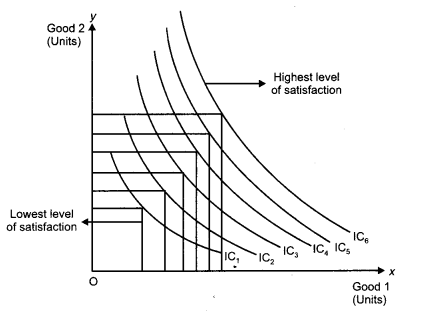
The above figure depicts an Indifference Map comprising of six indifference curves (from IC
1
to IC
6
). AS the consumer moves farther away from IC
1
to higher indifference curves the level of satisfaction derived by the consumer increases. IC
6
depicts the highest level of satisfaction. On the other hand, IC
1
depicts the lowest level of satisfaction.
An indifference curve is downward sloping from left to right. It implies that a consumer cannot simultaneously have more of both the goods. An increase in the quantity of one good is associated with the decrease in the quantity of the other good. This is in accordance with the assumption of monotonic preferences.
Question 12.
A consumer buys 10 units of a commodity at a price of ₹ 10 per unit. He incurs an expenditure of ₹ 200 on buying 20 units. Calculate price elasticity of demand by the percentage method. Comment upon the shape of demand curve based on this information. [4]
Answer:
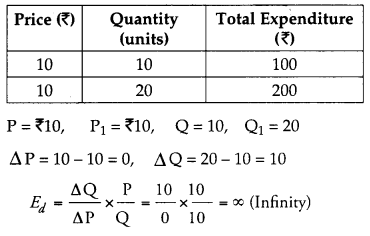
Since the price remains the same the shape of demand curve will be perfectly elastic. Demand Curve will be parallel to x-axis.
Question 13.
What does the Law of Variable Proportions show? State the behaviour of marginal product according to this law. [4]
OR
Explain how changes in price of inputs influence the supply of a product.
Answer:
The law of variable proportions shows how the product will be affected if one factor is variable and other is fixed. The law explains if the units of a variable factor are increased the total product will also increase. This law can be divided into three stages. The behaviour of MP curve will be as shown in the diagram.
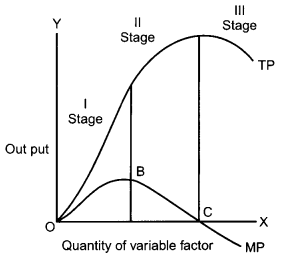
(i) In the first stage, the firm starts from the point of origin to the point where MP curve is maximum. According to diagram this stage is from point of origin to point B. In this stage MP curve rises and reaches the maximum.
(ii) In the second stage, MP curve ranges from point B (where it is maximum) to point C (where it is zero) i.e., MP decreases but is positive.
(iii) The third stage goes from point C and goes below X-axis. In this phase, MP decreases and gets negative. Therefore a firm always operates in the second stage.
OR
The increase in the cost of input or factors of production leads to an increase in the cost of production, which affects the supply of a commodity.
Example: When the prices of factors increases, the cost of production also increases. In the result, the supply of the commodity will be less at a given price.
Similarly, when the cost of inputs and the factors of production fall the cost falls. The cost of the product will not be changed. In this case producer will get profit. This induces producers to supply more.
Question 14.
Explain the difference between (i) Inferior goods and normal goods and (ii) Cardinal utility and ordinal utility. Give example in each case. [4]
Answer:
(i) Inferior goods are those goods whose demand falls with the increment in income of consumers. This is because when income rises the consumers want superior goods than before. Those goods which are affected negatively are called inferior goods.
Normal goods are those goods whose demand increases with the increment in income and vice- versa.
In short, when income increases the demand of normal goods increases and the demand of inferior goods decreases.
(ii) Cardinal Utility means the utility derived from units can be measured in numerical terms. Such as utility from first unit consumed is 8, from the another unit consumed is 6 etc. Unit analysis approach explains consumer’s behaviour which is based on cardinal approach.
Ordinal Utility approach explains the consumer’s behaviour in the case of preferences of the combination of two commodities instead of adopting cardinal utility approach. Indifference curve approach is basically based on ordinal approach because the fact that indifference curves express the level of satisfaction of the consumers which may be more or less. It cannot be measured in numerical terms.
Question 15.
Explain the difference between “change in quantity supplied” and “change in supply”. Use diagram. [6]
Answer:
Change in quantity supplied means the changes in supply which are caused by the changes in the price of the good, other things remaining constant. In this case, when price increases quantity supplied also increases and when price falls quantity supplied also falls. In this case, a movement along the supply curve takes place upwards or downwards as the case may be. As shown below in the diagram, when price increases from OP to OP
2
, there is a movement on supply curve from point E to point F. On the other hand, when price falls from OP to OP
1
, there is a movement downward on the supply curve from point E to point G. When price increases, Quantity supplied also increases and when price falls, quantity supplied also falls. This is clear looking at the diagram (i).
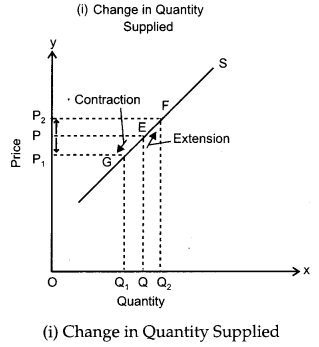
Change in supply. In case of change in supply, supply supplied increases or decreases due to factors other than price. These factors may be price of other commodities, state of technology, cost of production etc. In short, in the case of change in supply, the supply is either more or less at the same price.
In the case of change in supply, a shift takes place in the supply curve towards right when there is an increase in supply and towards left when there is a decrease in supply. As shown in the Diagram (ii), when supply curve shifts to S
1
S
1
supply falls from OQ to OQ
1
. On the other hand, when there is a shift in supply curve from SS to S
2
S
2
supply increases from OQ to OQ
2
. In both the cases price remains the same, i.e., OP.
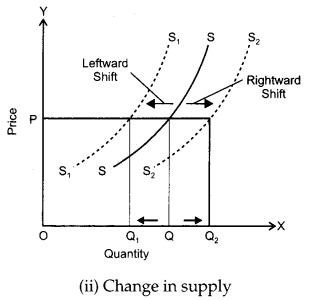
Question 16.
Market for a good is in equilibrium. There is simultaneous “decrease” both in demand and supply but there is no change in market price. Explain with the help of a schedule how it is possible. [6]
OR
Market for a good is in equilibrium. Explain the chain of reactions in the market if the price is (i) higher than equilibrium price and (ii) lower than equilibrium price.
Answer:
When the Quantity Supplied and Quantity demanded are equal then the market price is in equilibrium. According to the demand supply schedule given below, the equilibrium price is ₹ 7 where the quantity of demand and supply both are 16 units in other situation there is simultaneous decrement in both supply and demand but there is no change in market price. Therefore according to the new condition D
1
and S
1
is drawn. There is no change in market price, new demand and supply are equal at 12 units. Therefore the equilibrium quantity is 16 in the original condition. In the new situation equilibrium quantity is different but the price is the same i.e., ₹ 7. This has been possible because there is equal decrease both in demand and supply in the new situation. It is because of that the equilibrium quantity has fallen from 16 to 12 units.
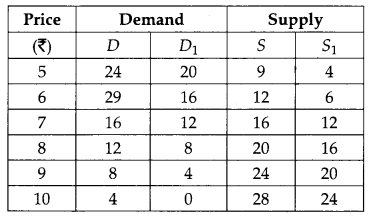
(i) When market price is higher than the equilibrium price : There is excess supply of goods and producers are not in a situation to sell all they want to sell at the given price. This leads to competition among producers which leads to lowering of price which in turn raises the demand and the supply reduces.
As shown in the diagram, equilibrium price is OP where equilibrium quantity is OQ. Say, if market price is fixed at OP
1
then there will be disequilibrium between demand and supply. Demand will be OQ
1
and supply OQ
2
, thus there will be excess of supply equal to Q
1
Q
2
. For bringing equality between demand and supply, market price should be reduced from OP
1
to OP, so that there is no excess supply.
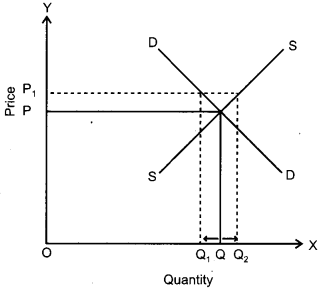
(ii) When market price is lower than the equilibrium price: There is excess demand and consumers are not able to buy all they want to buy at the given price. This leads to competition between consumers which leads to a rise in price. Rise in price reduces demand while raises supply. As shown in the diagram, equilibrium price is OP and quantity demanded OQ. If OP
1
is fixed as market price (lower than the equilibrium price), there will be excess demand equal to Q
1
Q
2
. Therefore for bringing about an equality between demand and supply, market price needs to be increased from OP
1
to OP, so that there is no excess demand.
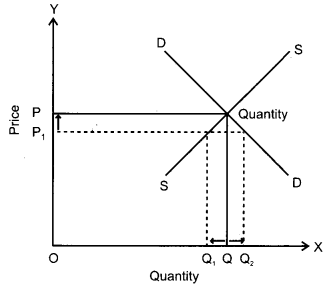
Section – B
Question 17.
Define flow variable. [1]
Answer:
Flow variable refers to those variables that are measured over a period of time. These variables have an element of time attached to them. For example, interest earned on bank deposits for 1 year, i.e., from October 01, 2009 to October 30, 2010 is a flow variable.
Question 18.
Define consumption goods. [1]
Answer:
Consumption goods are those goods which are ready for the consumption in satisfaction of human needs and wants and are not used in the production of another goods.
Question 19.
What are time deposits? [1]
Answer:
Those bank deposits which cannot be withdrawn before the expiry time which has already decided. These are bank deposits, such as fixed deposits.
Question 20.
Define a ”direct tax’. [1]
Answer:
Direct tax is a tax whose liability cannot be shifted to any other person. Example- Income tax.
Question 21.
What is a fixed exchange rate? [1]
Answer:
Fixed exchange rate is fixed by the Government/Central Bank. .
Question 22.
Find Net Value Added at Market Price : [3]
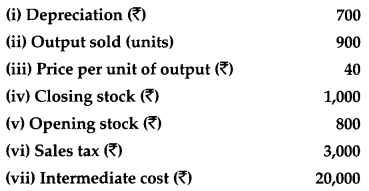
Answer:
Net Value Added at Market Price
= (Units of output sold × Price per unit of output) + Closing stock – Opening stock – Intermediate cost – Depreciation
= (ii) × (iii) + (iv) – (v) – (vii) – (i)
= (900 × 40) + 1,000 – 800 – 20,000 – 700
= [36,000 + 1,000] – 21,500 = ₹ 15,500
Question 23.
Explain the ‘standard of deferred payment’ function of money.** [3]
Question 24.
Outline the steps taken in deriving Consumption Curve from the Saving Curve. Use diagram, [3]
Answer:
Before deriving consumption curve from saving curve we should know the following:
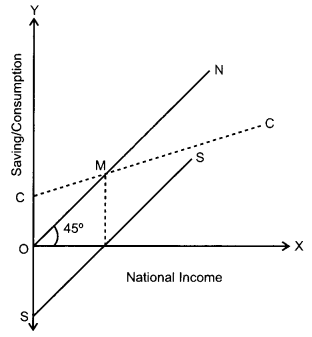
(i) Y = C + S
∴ S = Y – C
(ii) C = Autonomous consumption + That part of income which is consumed, as such.
When C is positive, saving is negative and when C = Y, S = 0
(iii) On the basis of this information, we can draw consumption curve and saving curve as shown in the diagram.
In the diagram, SS is saving curve. At OS level of income C = Y, therefore S is zero. Beyond that SS becomes positive. When SS is positive consumption is less than income and the part of consumption curve is MC.
Question 25.
Find Consumption Expenditure from the following: [3]
National Income = ₹ 5,000
Autonomous Consumption = ₹ 1,000
Marginal propensity to consume = 0.80
Answer:
National Income, Y = ₹ 5,000
Autonomous consumption (a) = ₹ 1,000
Marginal propensity to consume (b) = 0.80
∴ Consumption, (C) = a + bY = 1,000 + 0.8 (5,000)
= 1,000 + 4,000 = ₹ 5,000
Question 26.
Distinguish between revenue receipts and capital receipts in a government budget. Give example in each case. [3]
OR
Explain the role of government budget in bringing economic stability.
Answer:
Revenue receipts are those which do not either create a liability or lead to a reduction in assets, such as tax revenue.
Capital receipts are those funds which government raises either by incurring liability or by disposing of assets, such as recovery of loans, loans raised etc.
OR
Ensuring economic stability is one of the important objectives of a government budget. Government aims at insulating the economy from major economic fluctuations (such as inflation, unemployment, etc.) and the business cycles such as boom, recession, depression and recovery. It aims at achieving higher economic growth rate while combating such situations. Through the budget policy, government aims at maintaining price and employment stability. This aim of economic growth with stability ensures a smooth and efficient functioning of an economy.
Question 27.
Should the following be treated as final expenditure or intermediate expenditure? Give reasons for your answer. [4]
(i) Purchase of furniture by a firm.
(ii) Expenditure on maintenance by a firm.
Answer:
(i) Purchase of furniture by a firm is a final expenditure because firm does not invest on the furniture daily. So it is a kind of investment.
(ii) Expenditure on maintenance by a firm is an intermediate expenditure because it occurs again and again and is not of permanent nature.
Question 28.
Explain the Tender of last resort’ function of the central bank. [4]
OR
Explain ‘government’s banker’ function of the central bank.
Answer:
When commercial banks exhaust all resources to supplement their funds at the time of liquidity crisis, the Central bank acts as the lender of the last resort for them. When Commercial banks cannot meet obligations of their depositors, the Central bank comes to their help. The Central Bank advances credit against eligible securities subject to certain terms and conditions. This saves the Commercial banks from a possible breakdown. This is an important function of the Central banks in the banking system of a country.
OR
The Central bank works as a Commercial bank for the government. Central bank provides all services and facilities to the government like ordinary banks provides services to public. Central Bank manages funds of all government departmental undertakings and the funds of government. It also provides loans when • government needs. It manages Public debt also. It also accepts the payment of taxes from the public on the behalf of the government and makes payment for the cheques issued by government. Deficit financing through borrowing from RBI.
Question 29.
Explain the concept of ‘fiscal deficit’ in a government budget. What does it indicate? [4]
Answer:
Fiscal deficit refers to the excess of total expenditure over total receipts during the given fiscal year including borrowings.
- If fiscal deficit is increasing then the amount of debt repayment is also increasing. The total borrowing of the government are increasing.
- If government requires borrowing then it may borrow from Reserve Bank of India. When RBI prints new currency to meet the deficit requirements it increases the money supply in the economy and creates inflationary pressure.
- The debt and financial burden of interest payments on the revenue expenditure causes a reduction on the capital expenditure for growth and development of the economy.
Question 30.
Find out (i) Gross National Product at Market Price and (ii) Net Current Transfers to Abroad : [4]
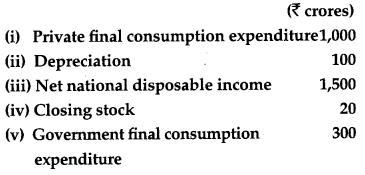
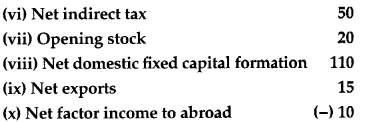
Answer:
(i) GNP
MP
= Private final consumption expenditure + Government final consumption expenditure + (Net domestic fixed capital formation + Closing stock – Opening stock + Depreciation) + Net exports – Net factor income to abroad.
= (i) + (v) + [(viii) + (iv) – (vii) + (ii)] + (ix) – (x)
= 1,000 + 300 + (110 + 20 – 20 + 100) + 15 – (-10)
= 1,300 + 210 + 15 + 10 = ₹ 1,535 crore
(ii) Net Current Transfers to Abroad = GNPMP – Depreciation – Net national disposable income
= GNP
MP
– (ii) – (iii)
= 1,535 -100 – 1,500
= ₹ (-) 65 crores
Question 31.
Explain the concept of ‘inflationary gap’. Also explain the role of ‘legal reserves’ in reducing it.
OR
Explain the concept of ‘deflationary gap’. Also explain the role of ‘margin requirements’ in reducing it. [6]
Answer:
Inflationary Gap: The situation of inflationary gap arises when equilibrium is established after the stage of full employment. The excess of aggregate demand over aggregate supply at the full employment level is inflationary gap. For bringing equality between AD and AS as the full employment level AD has to be reduced because AS cannot be increased since all the resources are fully employed.
(i) Legal reserves: Legal reserves refer to a minimum percentage of deposits commercial banks have to keep as cash either with themselves or with the central bank. The central bank has the power to change it. When there is inflationary gap the central bank can raise the minimum limit of these reserves so that less funds are available to the bank for lending. This will reduce Aggregate Demand.
(ii) Bank rate: Bank rate is the rate of interest which central bank charges from commercial banks for giving them loans. If bank rate is increased, the rate of interest for general public also goes up and this reduces the demand for credit by the public for investment and consumption. Therefore, for controlling the situation of inflationary gap, bank rate is increased. This ultimately will lead to the decline in the demand for credit. Decline in the volume of credit as a component of money supply will have controlling pressure on inflationary forces.
OR
The situation of deflationary gap arises when equilibrium is established before the stage of full employment of output. In this case, at the full employment level, aggregate demand is less than aggregate supply. In the diagram, DEF is deflationary gap. For removing deflationary gap, the level of aggregate demand needs to be increased.
Margin requirements: Commercial banks never advance loans to its customers equal to the full value of collateral or securities. They always keep a margin with them, such as keeping a margin of 20% and advancing loans equal to 80% of value of security. The rate of margin is determined by the Central bank. In the situation of deflationary gap, this margin will be reduced so that more credit may be advanced against the security.
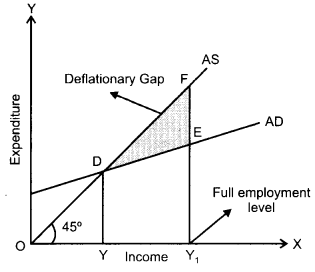
Question 32.
Give the meaning of ‘foreign exchange’ and ‘foreign exchange rate’. Giving reason, explain the relation between foreign exchange rate and demand for foreign exchange. [6]
Answer:
Foreign exchange: It means foreign currency. It also means the stock of foreign currency of a country. The total reserves of foreign currency is the stock of foreign currencies that a country holds at a given time.
Exchange rate: The rate for exchanging domestic currency (say ₹) into another currency (say US$) is known as exchange rate. The rate of exchange represents the value of home currency.
For Example if US$ 1 is equal to 60.86 Indian rupees then exchange rate between American dollar and Indian rupee is $1 = ₹ 60.86.
There is an inverse relationship between foreign exchange rate and demand for foreign exchange. Higher is the exchange rate, and lower is the demand for foreign exchange and vice-versa. The inverse relation between the two can be explained by an example if price of US dollar in India falls down from ₹ 60.86 to 55 it means now Indian people will pay 55 for US $1 instead of ₹ 60.86. This means American goods have become cheaper for Indians. When exchange rate decreases, the demand of foreign currency decreases and vice-versa.
CBSE Previous Year Question Papers Class 12 Economics 2012 Outside Delhi Set – II
Section – A
Question 6.
Explain the central problem of ‘how to produce’. [3]
Answer:
A number of methods are available to a producer for producing a good. First a producer decides how he should combine all factors in producing a commodity. A producer will use that combination or technique of production where the cost is minimum. This is the central problem of how to produce in an economy.
Question 9.
A fanner takes a farm on rent and carries on fanning with the help of family members. Identify explicit and implicit costs from this information. Explain. [3]
Answer:
- In the given example, the farmer carries on farming with the help of family members. If these members had worked elsewhere they would have earned wages. Therefore, the imputed expenditure incurred on the wages of family members is implicit cost.
- The farmer takes the farm on rent. Therefore, the expenditure incurred on rent (input) is explicit cost.
Question 11.
Define a budget line. When can it shift to the right? [4]
Answer:
A budget line graphically shows the many combinations of two goods which a consumer can buy, given his entire income and the prices of the two goods. A budget line, as shown in the diagram is a straight line having a negative slope.
There will be a shift in the budget line towards right when:
(1) Income of the consumer increases, prices of both the goods given, as shown in diagram (i).
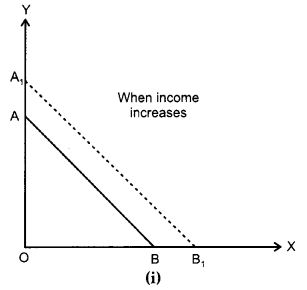
(2) Price of either of the two commodities or of both of commodities fall, as shown in diagram (ii).
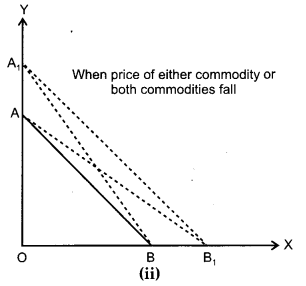
Question 12.
A consumer buys 14 units of a good at a price of ₹ 8 per unit. At price ₹ 7 per unit he spends ₹ 98 on the good. Calculate price elasticity of demand by the percentage method. Comment upon the shape of demand curve based on this information. [4]
Answer:
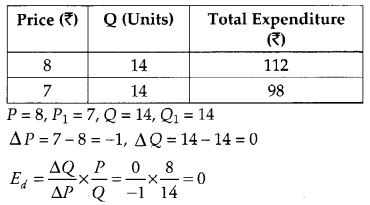
Therefore, the shape of demand curve will be perfectly inelastic.
Section – B
Question 22.
Find Gross Value Added at Factor Cost: [3]
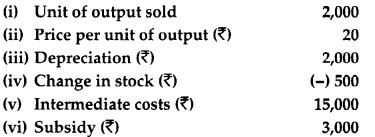
Answer:
Gross Value Added at Factor Cost
(Units of output sold × Price per unit of output) + Change in stock – Intermediate costs + Subsidy
= [(i) × (ii)] + (iv) – (v) – (vi)
= (2,000 × 20) + (-500) – 15,000 + 3,000
= 40,000 + 3,000 – 15,500 = ₹ 27,500
Question 25.
Find National Income from the following : [3]
Autonomous Consumption = ₹ 100
Marginal propensity to consume = 0.60
Investment = ₹ 200
Answer:
Given : Autonomous Consumption = 100
MPC = 0.60
Investment (I) = 200
∴ Income (Y) = a + bY + I
= 100 + 0.6Y + 200
⇒ (Y – 0.6) = 100 + 200 = 300
⇒ Y (0.4) = 300 × \(\frac{10}{4}\)
⇒ Y = 300
∴ Y = ₹ 750
Therefore National Income is ₹ 750 crores
Question 27.
Giving a reason, explain how should the following be treated while estimating national income : [4]
(i) Expenditure on free services provided by government.
(ii) Payment of interest by a government firm.
Answer:
(i) It should be included because it is a government final consumption expenditure.
(ii) It should not be included because it is an intermediate cost.
Question 30.
Find out (a) National Income and (b) Net National disposable Income * * : [4, 2]
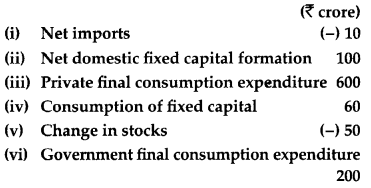

Answer:
(a) National Incomes = Private final consumption expenditure + Government final consumption expenditure + [Net domestic fixed capital formation + Change in stocks] – Net imports – Net factor income to abroad – Net indirect tax
= (iii) + (vi) + [(ii) + (v)] – (i) – (vii) – (ix)
= 600 + 200 + [100 + (-50)] – (-10) – 20 – 70
= 800 + 100 – 50 +10 – 90 = 910 -140 = ₹ 770 crores
CBSE Previous Year Question Papers Class 12 Economics 2012 Outside Delhi Set – III
Note : Except for the following questions, all the remaining questions have been asked in previous sets.
Section – A
Question 6.
What is Opportunity Cost? Explain with the help of an example. [3]
Answer:
The cost of enjoying more of one good in terms of sacrificing the benefit of another good is termed as opportunity cost of the additional unit of the good.
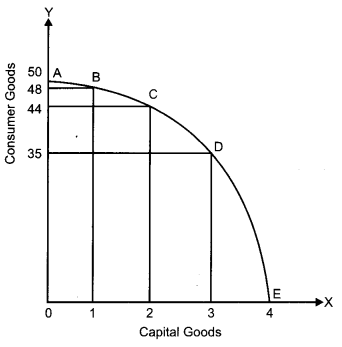
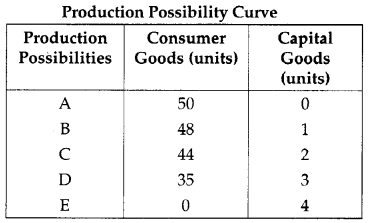
In the above figure, as we move downwards along the PPC from left to right (i.e. from A to E), we observe that in order to produce more units of capital goods, the economy must sacrifice some amount of consumer goods. In other words, it reflects the opportunity cost of producing one good in terms of another good. For example, a movement from point B to point C implies that the economy is diverting resources from the production of consumer goods to the production of goods. In order to produce one additional unit of capital good, the economy is sacrificing four units (i.e. 48 – 44 units) of consumer goods. Thus, the opportunity cost of producing one additional unit of capital goods is 4 units of consumer goods. Opportunity Cost from B to C
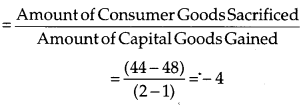
Question 9.
A producer borrows money and starts a business. He himself looks after the business. Identify implicit and explicit costs from this information. Explain. [3]
Answer:
- In the given example, the producer is borrowing money to start his business, So the expenses incurred (interest) on money borrowed is explicit cost.
- The producer looks after the business himself, therefore the imputed cost of the efforts of the businessman is implicit cost because of he had worked somewhere else, he would have earned some money.
Question 11.
What is budget set? Explain what can lead to change in budget set. [4]
Answer:
Budget set is the set of all consumption bundles of two goods that a consumer can afford at the same prices of goods which is given. It also shows the income level of consumers. The budget set changes because of changes in the price of the goods and changes in the income of consumer. Using M as income, P
1
as price of good X. P
2
as price of good Y. A consumer can buy any bundle which he can get by spending M on good X and good Y in the following manner:
P
1
X + P
2
Y ≤ M
This means money spent on good X and good Y should not exceed income. If there is any change in the budget set it takes place due to change in money variables fulfilling the basic condition stated above.
Question 12.
A consumer buys 8 units of a good at a price of ₹ 7 per unit. When price rises to ₹ 8 per unit he buys 7 units. Calculate price elasticity of demand through the expenditure approach. Comment upon the shape of demand curve based on this information. ** [4]
Section – B
Question 22.
Find out Net Value Added at Factor Cost: [3]
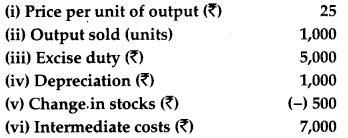
Answer:
NVA at Factor Cost 7,000
= [Price per unit of output × Output sold (units)] + Change in stocks – Intermediate costs – Depreciation – Excise duty
= [(i) + (ii)] + (v) – (vi) – (iv) – (iii)
= (25 × 1,000) + (-500) – 7,000 – 1,000 – 5,000
= 25,000 – 13,500 = ₹ 11,500
Question 25.
Find Investment from the following: [3]
National Income = ₹ 600
Autonomous Consumption = ₹ 150
Marginal propensity to consume = 0.70
Answer:
Given, National Income (Y) = ₹ 600
Autonomous Consumption (a) = ₹ 150
MPC (b) = 0.70
∴ Y = a + bY + I
or 600 = 150 + (0.7 × 600) + I
or 600 = 150 + 420 + 1
or 600 – 570 = I
or I = 30
Question 27.
How should the following be treated while estimating National Income? Give reasons. [4]
(i) Expenditure on education of children by a family.
(ii) Payment of electricity bill by a school.
Answer:
(i) Expenditure on education of children by a family is a final consumption expenditure of households because it is a payment for the services rendered by the school. It will be included.
(ii) Payment of electricity by a school is intermediate cost of the school and therefore is used for finding out value added and not directly included in the estimation of national income.
Question 30.
Find out (a) Net National Product at Market Price and (b) (Gross National Disposable Income**) form the following: [6]
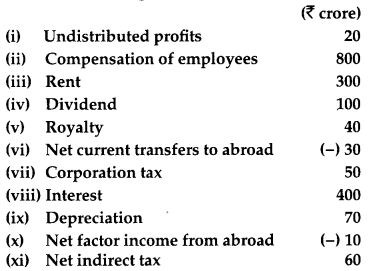
Answer:
(a) NNP
MP
= Compensation of employees + Rent + Royalty + Undistributed profits + Dividend + Corporation tax + Net factor income earned from abroad + Interest + Net indirect tax
= (ii) + [(iii) + (v)] + [(i) + (iv) + (vii)] + (x) + (viii) + (xi)
= 800 + (300 + 40) + (20 + 100 + 50) + (-10) + 400 + 60
= 800 + 340 + 170 – 10 + 460
= ₹ 1,760 crores